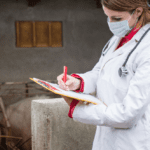 Movies and TV
Movies and TV  Movies and TV
Movies and TV  Creepy
Creepy 10 Lesser-Known Shapeshifter Legends from Around the World
 Animals
Animals 10 Amazing Animal Tales from the Ancient World
 Gaming
Gaming 10 Game Characters Everyone Hated Playing
 Books
Books 10 Famous Writers Who Were Hypocritical
 Humans
Humans 10 of the World’s Toughest Puzzles Solved in Record Time
 Mysteries
Mysteries 10 Scientific Mysteries We Don’t Fully Understand
 Weird Stuff
Weird Stuff 10 Celebrities Who Have Admitted to Alien Encounters
 Our World
Our World 10 Surprising Secrets of Notre Dame Cathedral
 Miscellaneous
Miscellaneous 10 Intriguing Origins of Popular Carnival Rides
 Movies and TV
Movies and TV 10 Actors Dragged out of Retirement for One Key Role
 Creepy
Creepy 10 Lesser-Known Shapeshifter Legends from Around the World
 Animals
Animals 10 Amazing Animal Tales from the Ancient World
Who's Behind Listverse?

Jamie Frater
Head Editor
Jamie founded Listverse due to an insatiable desire to share fascinating, obscure, and bizarre facts. He has been a guest speaker on numerous national radio and television stations and is a five time published author.
More About Us Gaming
Gaming 10 Game Characters Everyone Hated Playing
 Books
Books 10 Famous Writers Who Were Hypocritical
 Humans
Humans 10 of the World’s Toughest Puzzles Solved in Record Time
 Mysteries
Mysteries 10 Scientific Mysteries We Don’t Fully Understand
 Weird Stuff
Weird Stuff 10 Celebrities Who Have Admitted to Alien Encounters
 Our World
Our World 10 Surprising Secrets of Notre Dame Cathedral
 Miscellaneous
Miscellaneous 10 Intriguing Origins of Popular Carnival Rides
10 Unsettling Facts about the World’s Deadliest Diseases
Humans are fighting a relentless battle against deadly diseases. These microscopic threats can wield immense power. From global pandemics to almost eradicating societies, the world’s deadliest diseases have left an indelible mark on history.
Here are ten truly unsettling facts about these deadly afflictions. From their mysterious origins to the staggering toll they’ve exacted, these facts show how delicate the balance between health and sickness is.
Related: Top 10 Diseases You Can Get from a Dirty Gym
10 Cardiovascular Disease Death Rate
This statistic is as serious as a heart attack—literally. Cardiovascular diseases are the leading cause of death worldwide. But do you have any idea just how many deaths they make up?
According to Campbell County Health, “1 in 4 deaths in the United States is a result of heart disease.” Over 800,000 people die in the U.S. annually because of it; that’s one death every 36 seconds.
With the high death toll, it’s important to be aware of the symptoms that could lead to death. Here are the signs you might want to watch out for:
-
Chest pain or discomfort
-
Shortness of breath
-
Fatigue or exhaustion
-
Arm or Leg pain
-
Jaw or stomach pain, especially in women
-
Swelling in the legs, ankles, or feet
-
Heart palpitations
If you’re having any of these symptoms, you might want to talk to your doctor before you become another statistic.
9 Cancer Prevention
Cancer is the second most common deadly disease causing more than 600,000 deaths in the U.S. alone in 2022. At least one-third of cancer deaths could have been prevented through routine screenings, early detection, and treatment.
But how often should you get screened? Talk with your doctor to get a personalized plan, but here are a few of the basic guidelines:
-
Breast cancer: It’s recommended women who are over 40 choose to have annual mammograms. Once women are 45, annual screenings are strongly recommended as long as they are expected to live another ten years or longer.
-
Cervical cancer: Women should start screening at age 25 with a Pap test every three years, an HPV test every five years, or a combination of both tests every five years.
-
Colorectal cancer: Both men and women starting at 50 should be screened for colorectal cancer and adenomatous polyps, even without risk factors.
-
Lung cancer: An annual screening is recommended for heavy smokers.
-
Prostate cancer: Most men should start screening when they are 50.
8 Children with HIV
When you think about people living with the Human Immunodeficiency Virus (HIV), it’s typical for sexually active adults to come to mind. But the number of children living with this lifelong disease might shock you. And the geographic concentration of those suffering with it will catch you off-guard too. “70% of all people living with HIV (24.7 million) live in sub-Saharan Africa, including 91% of the world’s HIV-positive children.” HIV weakens the immune system, leading to Acquired Immunodeficiency Syndrome (AIDS), which increases the risk of severe infections and certain cancers.
HIV in children can be difficult to diagnose, and symptoms can vary depending on the child’s age. It’s tough to determine in infancy, but some signs include trouble gaining weight, diarrhea, and pneumonia. As children get older, they might show slowed growth, swollen lymph nodes, infections, and developmental delays. They may also have joint pain or swollen stomachs. Older children and teens might also develop a sickness similar to the flu.
7 You Could Have Tuberculosis Bacteria
If you’re a hypochondriac, you might want to skip this one. The World Health Organization says, “About one-quarter of the world’s population is infected with tuberculosis (TB) bacteria.” You could be walking around with TB and not even know it.
TB is an infectious disease caused by bacteria (Mycobacterium tuberculosis) that primarily affects the lungs and can be life threatening if left untreated. In most people who breathe in TB bacteria and become infected, the body is able to fight the bacteria to stop them from growing. This is called latent TB infection.
People with latent TB infection have no symptoms and don’t feel sick. The bacteria are “asleep” in their body and cannot spread. However, the bacteria can become active if the immune system can’t stop them from growing. When TB bacteria are active (multiplying in your body), this is called TB disease. People with TB disease are sick and may also be able to spread the bacteria to others.
6 Diabetes—the Silent Killer
Diabetes is a chronic metabolic disorder characterized by high blood sugar levels, leading to various complications affecting the heart, kidneys, eyes, and nerves. Unfortunately, too many people either don’t know or simply ignore the signs. In fact, “More than 37 million people in the United States have diabetes, and 1 in 5 of them don’t know they have it.”
Since diabetes is one condition that needs monitoring and care, that’s a sobering thought. If you’re concerned that you might have diabetes, it’s a good idea to watch for signs and talk with your doctor. The signs and symptoms of diabetes can vary, but here are some common signs that you might have diabetes based on the search results:
-
Frequent urination (especially at night)
-
Excessive thirst
-
Unexplained weight loss (despite eating normally)
-
Fatigue and weakness, even with rest
-
Blurred vision
-
Slow healing of cuts or wounds
-
Frequent infections (UTIs, yeast infections, or skin infections)
-
Increased hunger, even after eating
-
Numbness or tingling in your hands or feet
-
Dry and itchy skin
-
Mood changes and irritability
5 Seniors with Alzheimer’s Disease
A common misconception about Alzheimer’s disease is that it only affects your memory. And that’s true—Alzheimer’s and other progressive neurodegenerative disorders do result in memory loss and cognitive decline. But its effects can also be deadly. Based on research from the Alzheimer’s Association, “1 in 3 seniors dies with Alzheimer’s or another dementia. It kills more than breast cancer and prostate cancer combined.”
This disease attacks the brain and causes healthy cells to die. Alzheimer’s is one of the top 10 causes of death in American adults. However, Alzheimer’s in and of itself does not kill a person. The most common cause of death among Alzheimer’s patients is aspiration pneumonia. Because patients’ immune systems are often impaired, pneumonia is often fatal.
However, seniors with advanced dementia are usually too frail and immunocompromised to fight bacterial infections, even with the assistance of these drugs. Because of this secondary cause, deaths with a primary cause of Alzheimer’s disease and related dementias are seriously underreported.
4 Diarrheal Disease and Children
No one likes having diarrhea, but few realize it can become a disease. Unfortunately, this is one deadly disease that children are especially prone to. The World Health Organization stated that “Each year, diarrhea kills around 525 000 children under five.”
Contaminated food or water can cause severe diarrhea, leading to dehydration and death, particularly in developing regions. Diarrheal diseases can be prevented through a combination of measures.
-
Hand washing with soap before eating, after using the bathroom, and after changing a diaper.
-
Access to safe or treated drinking water.
-
The use of sanitation facilities and avoiding defecating in any body of water.
-
Food should be washed with safe water, cooked thoroughly, and served hot.
-
Vaccines for rotavirus and measles can help prevent diarrheal disease.
-
Exclusive breastfeeding for the first six months of life.
-
Good personal hygiene, including bathing regularly.
-
Health education about how infections spread.
-
Oral rehydration therapy (ORT) can help replace lost fluids and electrolytes.
Because it’s so preventable, sharing best practices for prevention can be a helpful way to lower those depressing numbers:
3 Drop the Cigarette for COPD
What if there was a way to significantly lower your odds of contracting a deadly disease—would you consider it?
Chronic obstructive pulmonary disease (COPD) is a group of progressive lung diseases that include chronic bronchitis and emphysema, often caused by smoking or exposure to harmful pollutants. In fact, “up to 90% of COPD cases could be prevented by not smoking.”
People with COPD who continue to smoke will experience more rapid lung damage compared to those who quit smoking. Quitting smoking is the best thing you can do to protect your lungs and prevent COPD from worsening.
Knowing these frightening facts doesn’t make quitting such a hard habit any easier, but it just might give you more motivation to try and quit. And it’s certainly a reason to never start.
If you have concerns about COPD or smoking, it’s best to consult a healthcare professional for personalized advice and guidance.
2 Pneumonia in Developing Countries
Pneumonia is an infection that inflames the air sacs in one or both lungs. The signs and symptoms of pneumonia can vary from mild to severe, depending on factors such as the type of germ causing the infection and your age and overall health. Apart from pneumonia and influenza, other lower respiratory tract infections can be severe and life-threatening, particularly in vulnerable populations.
With so many treatments available in Western medicine, the extreme dangers of pneumonia might seem like a thing of the past. But it’s still a life-threatening reality in many places around the world. Based on research by the National Library of Medicine, “150 million new episodes of pneumonia are identified per year worldwide, more than 90 % of which occur in developing countries.”
So what does deadly pneumonia look like? You might get a cough with colored or bloody mucus. Many patients experience sweating, fevers, and trouble breathing. From headaches to muscle pain and fatigue, there are plenty of physical signs to watch out for.
1 Hepatitis B Can Lead to Cancer
You’ve heard about Hepatitis B, but not many people understand just how serious this condition can grow to be. Chronic infections with these viruses can lead to liver cirrhosis and liver cancer, making them significant causes of morbidity and mortality globally.
Based on a study by the CDC, “25% of chronic hepatitis B infections progress to liver cancer.” In fact, the relationship between hepatitis B and liver cancer is pretty well-established. HBV attacks the liver and weakens its ability to perform important functions, such as filtering toxins from the blood and maintaining blood sugar levels. This leads to long-term inflammation and damage to the liver, which increases the risk of developing liver cancer.
Thankfully, there are a few ways to help prevent and treat this. Vaccination against HBV is an effective preventive measure to reduce the risk of both HBV infection and subsequent liver cancer. And regular monitoring, early detection, and appropriate treatment of chronic HBV infection can help reduce the risk of liver cancer.








